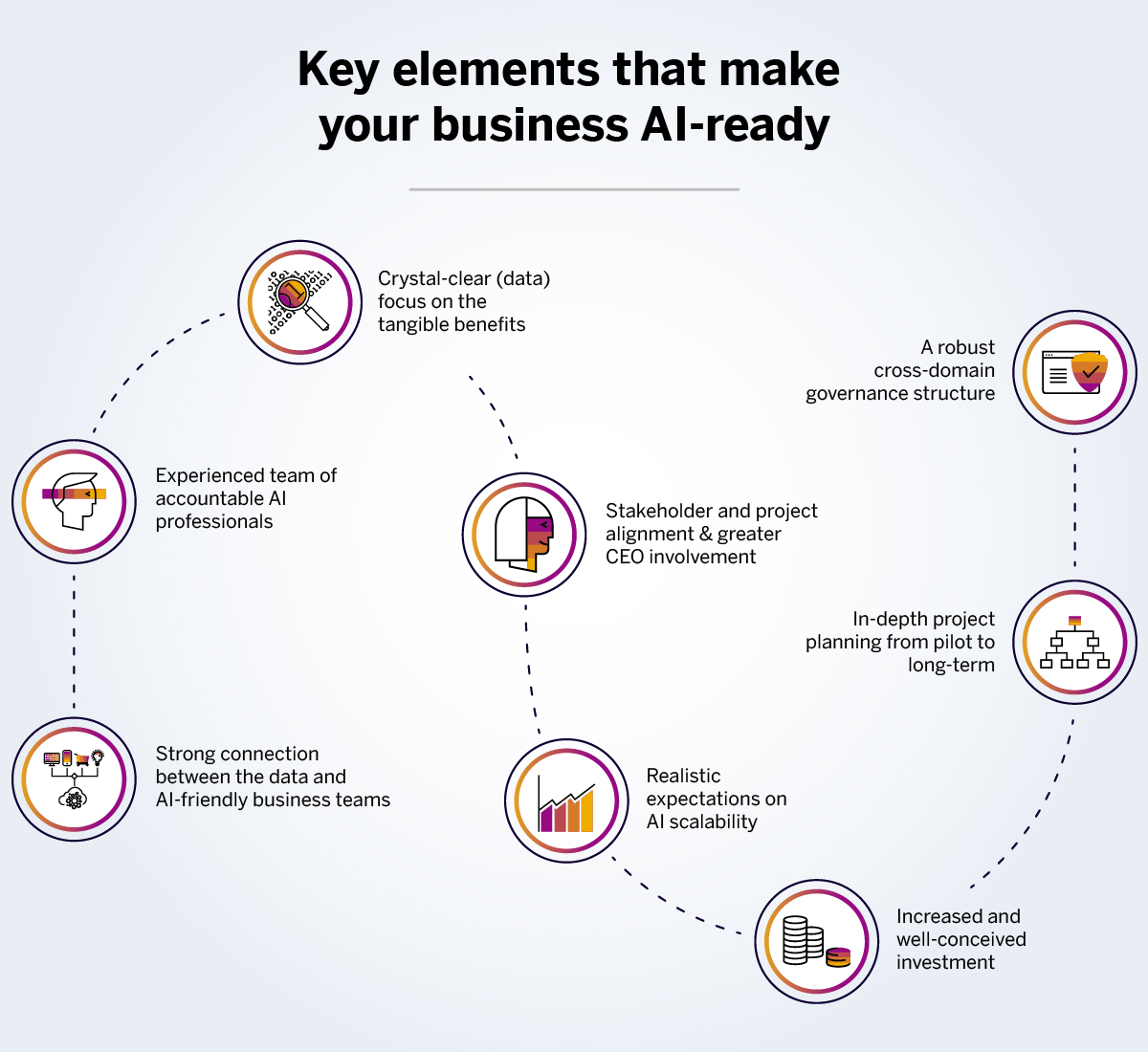The use of Artificial Intelligence in the business landscape is expanding. From predictive analytics to deep learning to chatbots and picture recognition, AI and machine learning are transforming how organizations communicate with customers and offer more in less time. And recent circumstances have sped up the pace of this transformation. According to research, the pandemic has accelerated AI rollout for 43% of businesses. Another study by KPMG claims that AI adoption has skyrocketed in finance (37%-point-increase), retail (27%-point-increase), and IT (20%-point-increase).

Clearly, AI is increasingly being used behind the scenes to help businesses improve efficiency, optimize operations, and boost productivity. However, many firms still struggle to understand how AI best fits their business strategy. Recent research indicates that 7 out of 10 companies reported minimal or no impact from the contributions of AI–a missed opportunity. Multiple studies and surveys have highlighted the significant differences between leaders—companies that understand and have implemented AI—and laggards. The comprehension of AI data and training, as well as the attitude to it, is one of the key differences.
To close the ‘AI-outcome-expectations gap,’ senior management needs to grasp the benefits AI brings to the table and understand the baseline strategies required to make a lasting, strategic change.
The advantages of AI for businesses today
Much has been written (and spoken) about AI and its use in business. Automation, data analytics, and natural language processing are just a few commercial areas where artificial intelligence is already in use. These three disciplines of AI are streamlining operations and increasing efficiencies across sectors. This leads to quantitative and qualitative advantages such as:
- Increased productivity: According to research, business productivity in developed countries can increase by up to 40% by 2035, owing to AI.
- Greater economic benefits: A Deloitte survey predicts that 83% of companies have already achieved either moderate (53%) or substantial (30%) economic benefits from their AI projects.

- More time for meaningful work: Companies often evaluate AI solutions in three key areas:
- Whether AI can automate processes to empower higher-value work (47%)
- Whether it provides trust in business outcomes (40%)
- Whether it offers the ability to deploy anywhere—on any public cloud, private cloud or on-premises (40%)
In other words, a robust AI solution can empower businesses to achieve business efficiencies and free up valuable human talent for skilled work.
- Improved business value: A study by Gartner suggests that AI augmentation will create $2 trillion of business value by 2021–equalling 6 billion hours of worker productivity worldwide.
- Competitive advantage: As per a study conducted by MIT, around three-quarters of executives attribute AI to be the key-enabler for venturing into new businesses. Around 85% believe AI will help the brand obtain–or sustain–a competitive advantage.
The list is endless. However, whether you’re a giant corporation with ample resources or a smaller firm with the much-needed nimbleness, AI adoption can be a tricky process. What is required is an understanding of the tradeoffs associated with each technology. Understanding these technologies and tradeoffs will help businesses decide how to best meet planned goals, which vendors to choose, and how quickly they can put a system like this in place.
Understanding–and bridging–the gap to be AI-ready
Not investing in the right AI-enablers can do more harm than good. To capitalize on AI’s true potential, businesses need to have a robust AI-centric strategy in place. Such a strategy ideally requires:
- A connection between the data and AI-friendly business teams: An IT-driven siloed AI operational model cannot produce impactful results. In fact, research indicates that increasing data complexity and data silos (32%) are top barriers to AI adoption. Clearly, AI and data by themselves lend little value to business operations.
To extract the deep-buried analytics and drive performance, the leadership team should reinforce greater collaboration and synergy between the data group and the business teams. The end goal is to solve the problems and issues together, preferably using a bottom-up approach. - Experienced and accountable AI professionals: Limited AI expertise or knowledge grapples 39% of organizations, according to a recent IBM Artificial intelligence is a completely different ball game. Companies need to reconfigure the workforce with the right mix of talent, skill, and experience in equal measure. While AI-powered initiatives are partnership-led, the entire effort should be championed by a single point-of-contact, for example, a Chief AI Officer.
- A crystal-clear (data)focus on the tangible benefits: To effectively tune out the data noise, there needs to be a ‘singular’ focus on choosing projects that can be categorized as absolutely ‘necessary.’ Moreover, the data and AI should be intrinsically tied to the corporate end-goals. If the business problem is not solvable by AI, all the effort and investment will go to waste. Long story short, these projects should be able to provide tangible values and benefits, such as lower customer churn, acquiring new customers, and so on. In addition, it is critical to view the end goals as use-cases or benefit-driven outcomes. This step is essential for value building and can build credibility within the teams.
- Strategic stakeholder- and project-alignment and a greater CEO involvement: This strategy focuses on building momentum and confidence within the stakeholders. A recent Accenture report throws light on the importance of strategic AI implementation. The report claims that strategically scaling AI offers 3X the return as compared to businesses pursuing siloed proof of concepts. This can easily happen if there is buy-in from all the key stakeholders across all three stages of project development: before, during, and after. By fostering stakeholder trust and leadership alignment early on in the project, businesses can pave the way for successful and sustainable projects.
- Realistic expectations on AI scalability: When scaling AI, most businesses fall into the ‘unrealistic expectations’ trap–a big mistake. A copy-paste approach never works with AI. What may work for some businesses might not work for others. Therefore, taking the time to link AI to the business strategy is key. There are numerous ways to do this, such as:
- Launching a proof-of-concept project that can effectively demonstrate value and providing the required ‘evidence’ before proceeding with full-force
- Starting small, with a simpler use case project, and gathering all the necessary data and technology to make the project feasible
- Experimenting and learning new approaches and not focusing on efficiency gains too much while experimenting
- Constantly measuring the efficacy of the AI solutions being used
- Spending enough time, effort, and energy into understanding how AI can deliver results within the business work environment
- Increased and well-conceived investment: One of the biggest factors of low-yielding returns is significant under-investment into the existing infrastructure. To leverage artificial intelligence and create an analytics-ready foundation, it is high-time organizations invest in fair and trustworthy tools and platforms. These tools should ideally be explainable by design and should enable enterprises to develop AI models seamlessly and scalably. There’s also a greater need to invest in new skills and expertise on a significant scale.
- In-depth project planning from pilot to long-term: AI projects should always be viewed with respect to ‘progress’ down a funnel. There should be a clear idea and proof-of-concept at the beginning and detailed steps for execution towards the end. This type of project pipeline can be augmented with tried-and-tested project management principles such as resource analysis, stakeholder communication, change management analysis, etc.
- A robust governance structure: Enterprises need to build trust within and outside the organization to unlock untapped potential of artificial intelligence. Being AI-driven means bringing about a change in mindset rather than mindlessly upgrading a stack of futuristic software. By building a transparent and cross-domain structure around data governance, organizations can leverage best practices and benefit from a solid AI-ready foundation. It is all about identifying the right roles, setting realistic expectations, and managing accountability.

AI is augmenting multiple business areas; from automating everyday workflows to enhancing the customer experience, its applications are aplenty. But there are some real questions business leaders should be asking themselves:
“Am we actually leveraging the full potential of AI, is it designed to fit the business needs?”
“Are we able to move past the deployment and adoption barriers?”
“Are we genuinely AI-ready?”
In short, instead of viewing AI projects as a one-off investment or embracing it as a tangent of moonshot thinking, businesses need to have:
- An AI-first strategy: Having complete clarity and vision of artificial intelligence and data across the value chain is the stepping stone to success.
- A strong skills and culture-driven base: The next logical step is to build a foundation based on strong technical know-how and a stronger ‘AI-ethics-driven’ cultural mindset. Furthermore, businesses need to forge ahead with greater trust, collaboration, and systematic alignment between teams and instill a culture of experimentation to drive AI innovation.
- An iterative and adaptive approach in place: Businesses need to be ever-ready to make changes to the business initiatives, the people, and the processes as required. Without an iterative approach and agile decision-making, leaders can get stuck in a rut.
In short: AI-readiness for organizations is not a small ask. It requires a cultural shift, a change in the technological paradigm, and most importantly, an establishment of a data-driven value chain that is people-focused–be it the internal employees or the external stakeholders. Irrespective of the tools, platforms, skills, or methodologies organizations embrace, a tangible, intentional, and change-focused AI strategy will always emerge as the winning combination.



